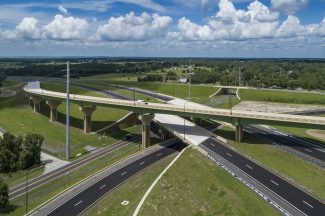August 25, 2020 Project of the Week

Project Name: Orlando Sports & Entertainment Smart District
Company Name: OS+ED Dev Corp
Project Location: Orlando, Florida United States
Project Information/Details: A ground-breaking Digital Twin project by Cityzenith promote, optimize, and future proof the ambitious $500 million Orlando Sports & Entertainment Smart District (OS+ED), aiming to drive the Florida city’s millions of annual visitors to the downtown hotspot. Confirmation follows a commercial agreement with SISCO, the project’s technology provider, finalizing terms with Cityzenith (CZ) and the project owners, OS+ED Dev Corp, to deploy CZ’s award-winning SmartWorldPro2™ Digital Twin platform for the first time on a megaproject in the United States. SmartWorldPro2 Integrates all software and services used by anyone designing, constructing, and managing complex, large-scale building projects, properties, and real estate portfolios. The OS+ED is planned opposite the Amway Center in downtown Orlando, where the Orlando Magic play basketball, and will include a 300-room hotel, 420,000 square feet of offices, 80,000 square feet of event space, more than 100,000 square feet of retail, and an open-air plaza. It will be a fully interconnected Smart District, using state-of-the-art IoT, Digital Twin and AI Technologies to transform the four-block urban core, west of the I-4 Highway. Cityzenith CEO Michael Jansen said: “I’m delighted to sign with SISCO to launch the visionary OS+ED project. Efforts are already underway to develop a hi-res 3D Digital Twin model of the core project site, the 130-acre OS+ED Smart District site, and the surrounding urban neighborhood, which will encompass most of Orlando. The result will be the most-advanced and feature-rich 3D Digital Twin model of a city in the United States. “It is our first major project of this scale in America and will highlight how SmartWorldPro2™ is able to integrate with SISCO’s IoT, artificial intelligence, smart building, and other technologies to deliver a comprehensive Digital Twin-enabled, Smart Connected Community Integrated Operating System (SCCiOS) for large building owners and operators.” Job #1 for SCCiOS will be attracting tenants and visitors to downtown Orlando venues for a ‘wow, it feels like I’m really there’ 3D District Experience, delivering an unprecedented wealth of information and connected services. The pioneering work could also unlock additional contracts for Cityzenith on other SISCO projects totaling up to $1,000,000 by the end of 2021. Phil Tinsley, CEO of the OS+ED Dev Corp, said: "The project is a highly programmed, high amenity development where residents, visitors and tenants experience Living-as-a-Service™ (LaaSTM) the first bundled entertainment, ticketing, hospitality, housing, transportation, food and beverage, wellness, and utilities platform of its kind in the US. “We chose Cityzenith’s SmartWorldPro2 Digital Twin to best demonstrate and bring this data rich experience to life and are thrilled to be its first major US user.” Tinsley predicted that tenants and residents would particularly love the easy-to-use ‘single-pane-of-glass’ software platform, accessing all the information they need when they need it, adding: “SmartWorldPro2’s unique features will first create an online virtual 3D tour like no other; a video game-like experience where visitors navigate to and click on elements in a life-like 3D OS+ED model to see event times, retail offers, parking availability, and even the view from their hotel rooms or stadium seats.” Michael Jansen added: “The OS+ED is high-profile, forward thinking, and transformational, and the contract is a huge victory for us, while also boosting our Cityzenith ‘Clean Cities – Clean Future’ mission. “Currently, 10,000 cities produce 70% of global greenhouse emissions and just 100 – megalopolises like New York, Tokyo, London and Paris – produce 25% of that total. “It must change and SmartWorldPro2™’s ability to create digitally-twinned cities to inventory GHG emissions and streamline sustainable urban redevelopment initiatives makes it the platform of choice for executing energy transition projects on any scale, whether a district, a campus, a city, or an entire country. “Please join us on our journey and watch for more updates as SmartWorldPro2™ marches towards cleaning and freeing our cities for a better future.”
August 18, 2020 Project of the Week

Project Name: Wekiva Parkway #204 Systems Interchange
Company Name: Central Florida Expressway
Project Location: Orlando, Florida United States
Project Information/Details: When Orange County, Fla., needed a new interchange to relieve traffic congestion and provide fully directional access between two state expressways, they turned to the Florida Department of Transportation (FDOT) for help. FDOT agreed to provide a Transportation Infrastructure Finance and Innovation Act (TIFIA) loan, which is designed to give credit assistance for qualified projects of regional significance. The loan would help Orange Country deliver the Central Florida Expressway (CFX) with savings of approximately $260 million through bond interest payments. However, the project team had to meet the completion deadline to get the money. It was one of many challenges the project faced, says Susan Gratch, vice president of transportation and civil practice engineer for Atkins North America. Her team used a precast concrete solution to mitigate many of the risks they faced. “Precast concrete provided cost-effectiveness, shorter fabrication delivery time frames, reduced maintenance, and enhanced durability,” she says. The design team had considered a steel alternative; however, the reduced long-term life-cycle costs and durability benefits led the team to move forward with precast concrete. A first time for U beams The project required construction of eight precast concrete girder bridges, and the engineers soon decided to use haunched, curved, post-tensioned concrete U-beams for the design. It would be the first use of these haunched U-beams in Florida. The decision provided the designers with a structurally efficient solution that delivered a pleasing aesthetic appeal within the allotted budget. “Precast concrete offered the ability to deliver the haunched feature on the girders and the greater spans through the use of post-tensioning,” Gratch says. The precast concrete U-beams were post-tensioned to extend the spans up to 150 ft, minimizing the number of piers in this environmentally-sensitive corridor. The use of a post-tensioned pier for the mainline crossing of Ramp K saved 12 ft in bridge height compared to conventional expansion piers. It also allowed lower column heights and walls, and reduced the footprint of the project. The design also accommodated future widening requirements by using a single precast concrete U-beam to provide an additional lane on each side. During design, the engineer worked closely with local precast concrete manufacturer to develop standard details for repetition that mimic colors, textures, and shapes from the natural environment. The designers also worked with the precast concrete producer to optimize the forming, shipping, and handling of the curved and haunched concrete beam segments, as the units required custom formwork and setup. “Working closely with a local and well-respected precaster was key to meeting all of the owner’s goals,” Gratch says. Once forms were established, the box width and web slope were made consistent to increase repetition of details and speed up the precasting processes. “This interchange design represents a holistic design approach encompassing form, function, safety, aesthetics, and maintenance,” she says. “It demonstrates to the public that transportation infrastructure can be beautiful.”
Project of the Week

Project Name: Genova San Giorgio Bridge
Company Name: RINA
Project Location: Genova, Italy, Armed Forces Europe
Project Information/Details: The Genova San Giorgio bridge reopened just 15 months from the start of construction work. Managing a project of this size and complexity relies on good planning and RINA, the Project Management Consultant for the project, was instrumental in managing both the demolition of the old Morandi bridge and the construction of the new Genova San Giorgio bridge, in an exceptionally short time. The numbers make interesting reading, there were over 220,000 hours of engineering work generating more than 3,200 technical documents and reviewing over 1,500 project sheets. A team of 80 RINA specialists was dedicated to managing the project guiding the construction phases, timelines, budgets and progress of the work. There were 20 sites operating simultaneously, 7 days a week, 24 hours a day without interruption for almost two years, apart from Christmas Day in 2019. RINA’s oversight across the entire project included responsibility for Works Supervision and Safety Coordination plus Quality Assurance during both the demolition and construction phases. Now, following the official inauguration of the new bridge, work will continue over the coming months to complete the restoration of the site areas below the bridge. “It seems incredible to think that just 596 days have passed since the start of activities and today we can at last pause to celebrate a project of reconstruction in the heart of Genoa,” said Ugo Salerno, President and CEO of RINA. “It all began with a tragic event that we will never forget. But now is the time to build on the positive energy that has been created and look to the future. The “Genoa Model” has already become well known and some say that it is not replicable in other projects, but I don’t think that’s true. Rapid construction is not a question of skipping procedural steps or paying less attention, but rather of planning each and every activity in detail to overcome the inevitable unforeseen events and get immediate and effective responses from all those involved, in particular from the public authorities. More broadly I believe that the restart of our country also depends on this: commitment and dedication combined with a public administration that does not hold back work.” “Although I love the term, it is not the ‘bridge of miracles’, but the result of excellent teamwork across all the stakeholders, with RINA playing a key coordinating and supervisory role,” explains Roberto Carpaneto, CEO of RINA Consulting. “The Project Manager is a concept that you can find all over the world, particularly in complex infrastructure projects. In Italy it is not so common. This lack of precise planning and optimal management of each step, from start to finish often results in projects being late and over budget. When rebuilding the Genoa bridge, natural disasters such as the floods in November 2019 and the Covid-19 pandemic required dynamic adjustments to the planning. RINA introduced physical protection, training and tracing, something that was started prior to the Italian government’s decision, but these steps did not lead to delays in completing the work. Managing some of the environmental challenges especially during the demolition which included reducing dust levels and preventing the threat of asbestos contamination were difficult but where achieved. I also want to thank the citizens of Genoa for the warmth and sympathy with which they have always supported our efforts.” As Project Management Consultants working directly for the Extraordinary Commissioner, RINA ‘bridged’ the gap between all stakeholders involved in the project. This role was necessary to ensure that all project requirements were delivered on time and on budget while liaising with all the construction companies and the people of Genoa. The design of the bridge has been termed as a ‘statement in its understatement’ accentuating the beautiful valley between mountain and sea and it will be truly environmentally friendly by including photovoltaic panels for energy, water treatment processes, and ongoing structural monitoring, that will ensure ongoing sustainability and safety. The importance of the bridge to the Genoese should not be underestimated together with the memory of those that lost their lives during the collapse of the original bridge. RINA provides a wide range of services across the Energy, Marine, Certification, Transport & Infrastructure and Industry sectors. With net revenues of EUR 476 million in 2019, a global network of over 3,900 talented professionals and 200 offices in 70 countries around the world, RINA participates in major international organisations and has contributed consistently to the development of new regulatory standards. www.RINA.org Facts & Figures and Infographic: https://www.rina.org/en/media/press-hub Drone video footage of demolition and construction phases: https://www.rina.org/en/media/press-hub/video-drone Time lapse video of entire project: To Watch or to To Download Video Statements: https://www.rina.org/en/media/press-hub/video-statements Project Timeline: 14 August 2018: Collapse of the Morandi Bridge. 15 November 2018: The Senate passes the Genoa Decree Law. 14 December 2018: The Mayor of Genoa and Extraordinary Commissioner for the Reconstruction, Marco Bucci, awards the contract for the demolition of the remains of the Morandi Bridge. 15 December 2018: The President of the Liguria Region, Giovanni Toti, and the Mayor of Genoa and Extraordinary Commissioner, Marco Bucci, officially open the construction sites for the demolition of the remains of the Morandi Bridge. 9 February 2019: Demolition of the Morandi Bridge begins. 15 March 2019: One of the last decks on the West side of the former viaduct is “lowered”. In the following months the structure will be completely demolished. 15 April 2019: Reconstruction officially begins with the placing of the first pile. 1 October 2019: The first deck is laid between pile 5 and pile 6. 25 June 2019: The first stone is laid with the casting of the base of pile 9 of the new “Ponte per Genova”, designed by architect Renzo Piano. 28 June 2019: The last remaining structure of the Morandi Bridge, piles 10 and 11, are demolished in a controlled explosion. February 2020: The first maxi beam of the new bridge over the Polcevera river is hoisted into place. 27 April 2020: The positioning of the last section of the new viaduct that begin. 28 April 2020: The last section of the viaduct is put in place; RINA looks at the complete deck of the new San Giorgio Viaduct. Beginning of August: Opening of the new San Giorgio Viaduct


